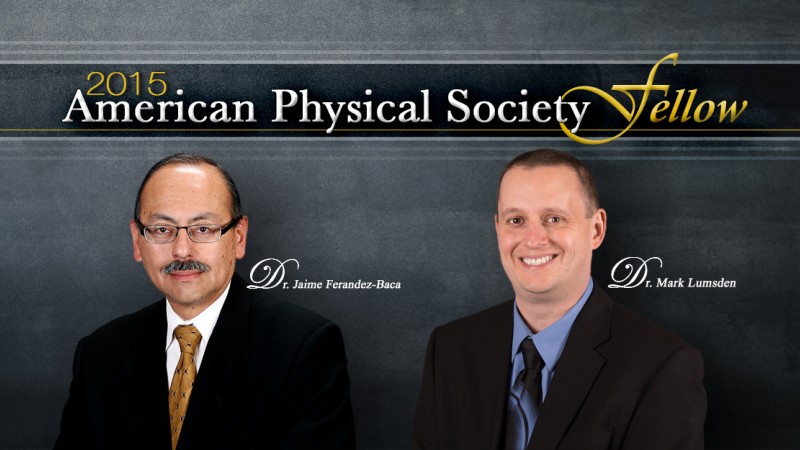Four researchers from the Department of Energy's Oak Ridge National Laboratory, including two from the Neutron Sciences Directorate, have been elected fellows of the American Physical Society (APS), one of the nation's top professional organizations for scientists.
Jaime Fernandez-Baca, Sergei Kalinin, Mark Lumsden and Thomas Maier were selected for the honor by the APS Council of Representatives. They will be formally recognized at the APS's March meeting.
Fernandez-Baca, a distinguished research staff member in the Quantum Condensed Matter Division in ORNL's Neutron Science Directorate, was recognized by the APS Division of Materials Physics “for seminal neutron scattering studies of magnetic materials, especially the spin and lattice dynamics of colossal magnetoresistive manganites.”
Fernandez-Baca’s research is performed mainly at ORNL's High Flux Isotope Reactor, where he is the lead for the Triple Axis Spectroscopy group. His expertise is in the study of the magnetic ordering and spin dynamics of complex oxides and related alloys using neutron scattering techniques. He was the recipient of the International Atomic Energy Agency fellowship, the DOE Office of Science Outstanding Mentor Award (2008) and the Neutron Scattering Society of America Distinguished Service Award (2014). Fernandez-Baca is also a joint faculty professor in the department of physics and astronomy at the University of Tennessee. He earned his doctorate at the University of Maryland-College Park.
Kalinin was cited by the APS's Division of Materials Physics for "foundational contribution to nanoscale electromechanics and revolutionary studies of defect-mediated phase transitions, energy conversion and electrochemical reactivity at the nanometer and atomic scales enabled by advanced scanning probe microscopy techniques."
He performs research in DOE's Center for Nanophase Materials Sciences at ORNL and directs the laboratory's Institute for Functional Imaging of Materials. He came to ORNL in 2002 as a Eugene P. Wigner Fellow after receiving his doctorate from the University of Pennsylvania. Kalinin received the inaugural Medal for Scanning Probe Microscopy from the Royal Microscopical Society earlier this year and is a 2009 Presidential Early Career Award recipient. He has authored more than 400 publications with more than 10,000 citations, edited three books and holds several patents on scanning probe microscopy.
Lumsden, a distinguished research staff member in the Neutron Science Directorate's Quantum Condensed Matter Division, was recognized “for contributions to understanding of magnetism in iron-based superconductors using neutron scattering techniques.”
After receiving his doctorate at McMaster University in Canada, Lumsden came to ORNL in 1999 as a Wigner Fellow. He joined the research team at the Spallation Neutron Source, where he now leads the Time-of-Flight Spectroscopy group. His research has been focused on using neutron scattering techniques, primarily at ORNL's High Flux Isotope Reactor and Spallation Neutron Source to study the magnetic structure and dynamics of unconventional superconductors and quantum magnets. Lumsden was the recipient of a Gordon Battelle Award for scientific research in 2011.
Maier, a senior research staff member in ORNL's Computer Science and Mathematics Division and in the Center for Nanophase Materials Sciences, focuses on many-body theory of correlated electron systems including unconventional superconductors, multilayers and nanostructures. He was cited by APS's Division of Condensed Matter Physics for "numerical and phenomenological calculations that have provided insight into cuprate and iron-pnictide superconductors."
Maier came to ORNL as a Wigner Fellow in 2003 after earning his doctorate from the University of Regensburg in Germany. He was a member of a team that won an ACM Gordon Bell Prize in 2008 for petascale simulations and has authored or co-authored more than 80 publications. Maier is also a joint faculty associate professor at the University of Tennessee.
The Spallation Neutron Source, High Flux Isotope Reactor and Center for Nanophase Materials Sciences are DOE Office of Science User Facilities.
UT-Battelle manages ORNL for the Department of Energy’s Office of Science. The Office of Science is the single largest supporter of basic research in the physical sciences in the United States, and is working to address some of the most pressing challenges of our time. For more information, please visit http://science.energy.gov/.







